The growth of large cities is often attributed to their proximity to exogenous, first-nature advantages. This column uses data on 450 Japanese cities to show that in fact, the regularity of agglomeration holds as a natural consequence of endogenous agglomeration and dispersion forces at the global or local level, rather than exogenous factors.
Many large cities are found at locations with certain first nature advantages. Yet, those exogenous locational features are not the most potent forces governing the spatial pattern of cities. In particular, the (population) size, spacing, and industrial composition of cities exhibit a simple, persistent, monotonic relationship. Theories of economic agglomeration suggest that this regularity is a consequence of interactions between endogenous agglomeration and dispersion forces.
Size and spacing of cities
Cities typically exhibit a central place pattern in the country, in which larger cities are surrounded by smaller ones, and are more spaced apart. Figure 1 shows the relationship between the size si of each city i and the distance di to its closest city of comparable size or larger for the 450 Japanese cities in 2015 (Note 1). The correlation between them is as high as 0.67, unconditional on the topographical heterogeneity of city location.
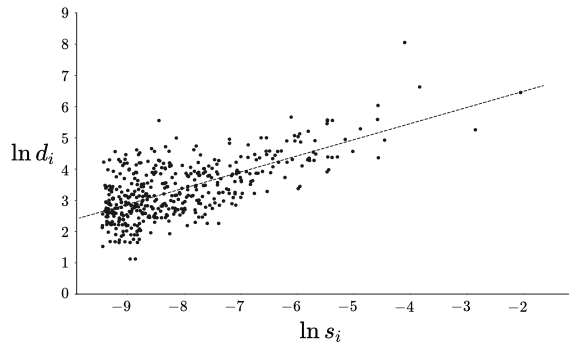
Size distribution of cities
It is well-known that city size distribution in a relatively self-sufficient economic region – typically a country – exhibits an approximate power law (e.g. Gabaix and Ioannides 2004). More specifically, if a given set of n cities satisfy a power law, the city size and their rankings have an approximately log-linear relation. Japan is an obviously mono-polar economy organised around Tokyo, and is a typical case in which the approximate power law for city size distribution holds at the country level (Note 2).
In Figure 2, Panel (a) shows the rank-size distributions of cities every five years from 1970 to 2015, where si indicates the share of city i in the national population. Panel (b) shows the change in the Zipf coefficient – the elasticity of rank with respect to city size – over these 45 years. One can see that the city size distribution exhibits an approximate power law in each year, although agglomeration towards larger cities has been accelerated. The variation in city size is remarkably large, as exhibited by the largest three cities – Tokyo, Osaka and Nagoya – accounting for 45% of the national population.
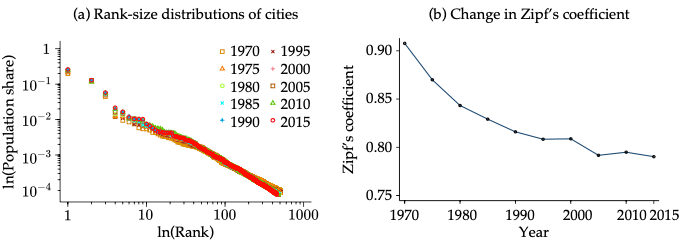
Size and industrial composition of cities
It is well-known that the size and socioeconomic quantities (e.g. wage, education level, GDP, industrial diversity, numbers of patent applications) of cities exhibit strong correlations (Note 3). The clearest such instance is industrial location. For the three-digit secondary and tertiary industries of the Japanese Standard Industrial Classification that are present in both 2000 and 2015, Figure 3 shows the relation between the number and average size of the cities in which industry i is located. The dashed curves indicate the upper and lower bounds for the average size, where the former is the average size of the largest Ni cities, and the latter is the average size of the smallest Ni cities.
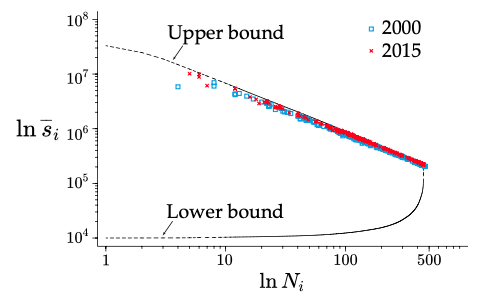
The figure indicates two key relationships between industrial location and city size. First, the number and average sizes of the cities exhibit a strong and persistent power law, designated as the number-average size rule by Mori et al. (2008). Second, the average sizes are almost hitting their upper bound, meaning that the set of the Ni cities comprises roughly the largest Ni cities. Hence, a hierarchical principle à la Christaller (1933) roughly holds, i.e. an industry found in a smaller city is also found in all the larger cities.
Mori et al. (2008) have formally shown that the number-average size rule is indeed a consequence of the simultaneous presence of the power law for city size distribution and the hierarchy principle.
Theory for central place pattern
Akamatsu et al. (2018) have shown that a wide variety of the extant models of agglomeration, once extended to a many-region setup, can account for the basic mechanism underlying the central place pattern (Note 4). Most existing theoretical models for city formation are static and involve a single type of mobile agent subject to the same degree of increasing returns (e.g. Krugman 1991, Beckmann 1976). In this context, they proposed a formal framework utilising a symmetric discrete racetrack geography to identify the spontaneous spatial pattern of cities that arises purely from agglomeration and dispersion forces.
In particular, they have shown that the existing models can be classified into three reduced forms in terms of their spatial patterns of cities, despite the difference in their specific mechanisms underlying agglomeration and dispersion forces. Figure 4 depicts the two polar cases out of the three cases. The class of models incorporating only global dispersion force are able to account for the formation of multiple distinct cities (Panel a), whereas only one city can form in the other class of models incorporating local dispersion force without global dispersion force (Panel b).
Formally, the dispersion force is global if it is dependent on, and local if it is independent of, interregional distance. An example of the global dispersion force is the demand for urban goods from dispersed consumers. Due to transport costs, urban producers are encouraged to locate near the dispersed consumers. As a consequence, multiple cities form so that firms in each city mainly serve their nearby markets. On the other hand, the local dispersion force accrues from, for example, locally scarce land for housing and congestion externalities. Since these dispersion forces are confined within a given city, and are independent of interregional distance, the local dispersion force pushes out mobile agents from inside the city. As a result, the dispersion in this case takes the form of spatial sprawl of a given city, rather than the formation of another city. The last class of models with both global and local dispersion forces can account for the formation of multiple cities, each with positive spatial extent.
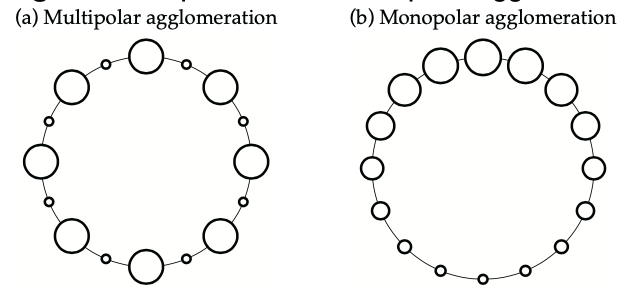
To account for the central place pattern, the global dispersion force is essential. In this class of models, the mobile agents completely disperse over all locations for sufficiently high transport costs, and as transport costs decrease, the agglomeration proceeds in the form of spatial-period doubling bifurcation, until all mobile agents concentrate in one city. Hence, the central place pattern is a typical consequence in this class of model (Note 5).
Theory to account for hierarchy principle and city size diversity
To account for the large variation in size and industrial composition of cities, in addition to the central place pattern, models need to incorporate diversity in increasing returns. The straightforward extensions of the models with global dispersion force discussed above include Fujita et al. (1999) and Tabuchi and Thisse (2011) in the new economic geography framework, whereas Hsu (2012) proposed an entirely new spatial competition model of firm entry. In these models, the different degrees of increasing returns among industries result in the different spatial frequencies of agglomeration in them.
In these models, the mechanism underlying city size diversity is the spatial coordination of agglomerations among industries through inter-industry demand externalities that arise from shared consumers. Industries subject to larger increasing returns agglomerate in a smaller number of cities that are farther apart. Larger cities are formed at the location in which a larger number of industries co-locate to share consumers. This spatial coordination of industries leads to the positive correlation between the size, spacing, and industrial diversity of a city.
Figure 5 depicts an example of such a coordination of four industries, "red," "blue," "green" and "black," in an economy with 16 locations. Each circle with a given color indicates the location of the industry corresponding to the color. Agglomerations of individual industries are equidistant, where the "red" industry is the most agglomerated, while the "black" one is ubiquitous. In the presence of inter-industry positive externalities, agglomerations of different industries coordinate spatially, and the hierarchy principle holds among cities (Note 6).
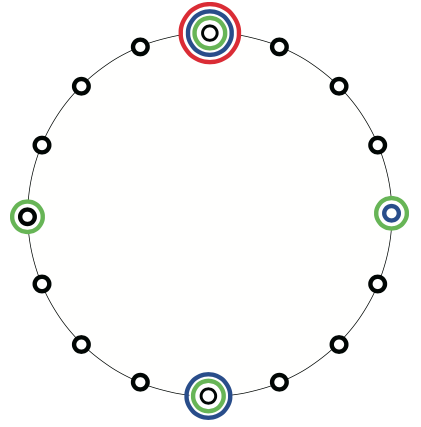
Conclusion
The location, size, and industrial composition of cities in reality can be characterised in terms of the central place pattern, power law, and hierarchy principle, respectively, as illustrated for the case of Japan. Despite the multiplicity of equilibria, the regularity appears to be a natural consequence of the self-organisation of an economy with endogenous agglomeration and dispersion forces, whereas no evidence thus far is available for concrete exogenous (or historical) factors accounting for the regularity. It follows that a place-based policy targeting an individual region is necessarily constrained by this endogenous regularity, so that the relative growth of an individual region tends to imply a relative decline of another region in the maintenance of the regularity. This column thus urges regional economists and policymakers to see the theories of agglomeration that have been developed in the past quarter of a century in a fresh light. See, for example, the recent development of the framework for systematic numerical analysis based on the numerical and group-theoretic bifurcation theory (e.g. Ikeda et al. 2012, 2017). Their approach enables us to explore the models of endogenous agglomeration with asymmetric geography as well as two-dimensional location space in a many-region setup.
Authors note: This column is based RIETI Discussion Paper 18-E-053.
This article first appeared on www.VoxEU.org on August 11, 2019. Reproduced with permission.


